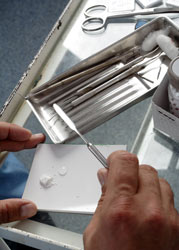Ultrasound treated materials for dental application
Mercury-based amalgams used for tooth filling are considered to be potentially toxic and environmentally unfriendly due to mercury's volatilisation after cremation. Alternative materials should display reduced wear, improved handling characteristics and resistance to secondary tooth decay, as well as capability of direct tooth bonding in order to preserve tooth structure. In answer to these needs, Glass Ionomer Cements (GICs) constituted a very good option. These materials are formed through reaction of aqueous poly-acrylic acid with an acid degradable glass. This results in a release of metal cations that further crosslink to the poly-acrylic acid. The end-product is cement consisting of residual glass particles embedded in a poly-salt matrix. These cements display unique features, such as the release of protective fluoride ions to the adjacent tooth structure that inhibits subsequent tooth decay. Yet, there are still some inherent problems including early hydrolytic stability and poor fracture toughness. Aiming to overcome these, the ULTRASET project developed innovative glasses for incorporation in the cements that could be further optimised under ultrasound application. The project studied an extensive range of cement structures under exposure to different ultrasound frequencies to obtain improved mechanical properties. Under exposure to ultrasound, the developed glass (ionomer) polyalkenoate cements were shown to display improved hydrolytic stability at short times after placement. With excellent mechanical properties, such as fracture toughness, strength and abrasive wear resistance they may be polished and shaped immediately after placement. Researchers gained a better insight on the clinical use and application of ultrasonic curing of these cements. Tests on the efficacy of new ultrasound tip geometries and delivery systems were also conducted. The ULTRASET project results can contribute to the reduction in the use of amalgam-based materials and consequently mercury contamination. Moreover, the advanced filling materials may considerably prevent tooth loss, which is highly associated with speech problems, eating disorders and loss of self-esteem. Their handling characteristics allow easy placement facilitating dentist's work significantly. Furthermore, associated costs for the patient may be substantially reduced in comparison to other filling materials.







